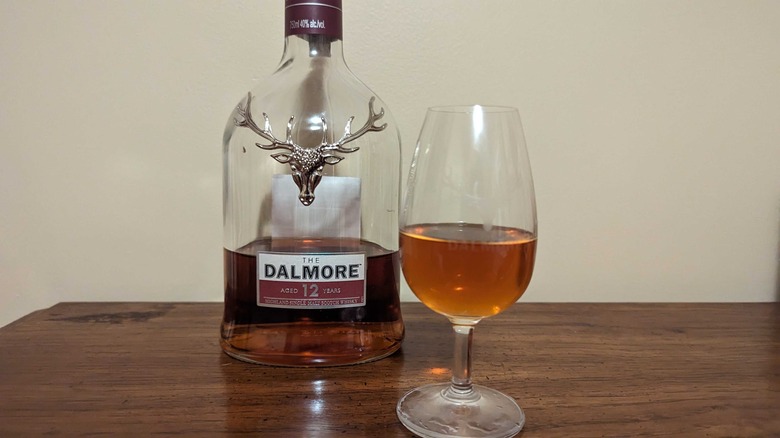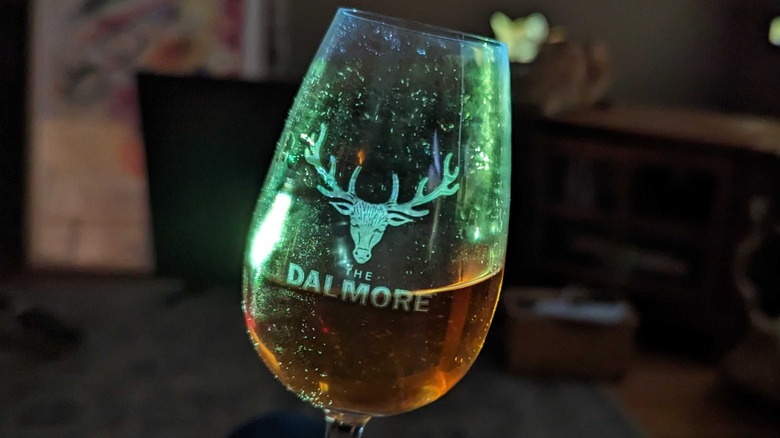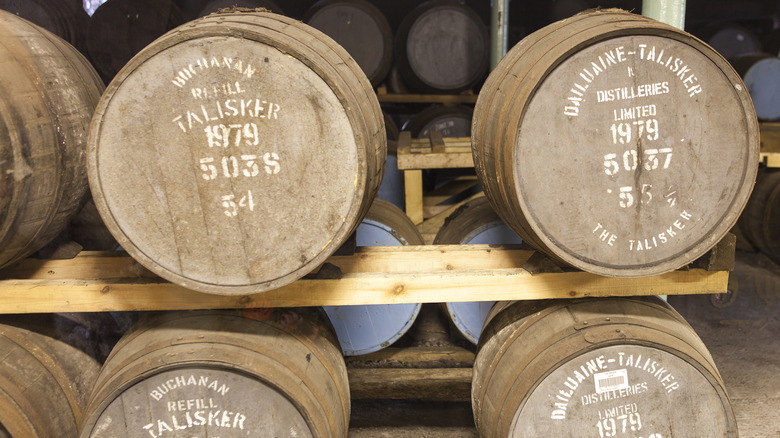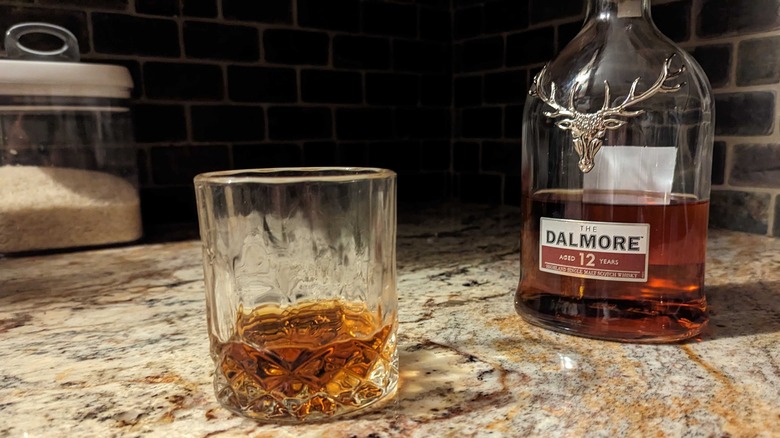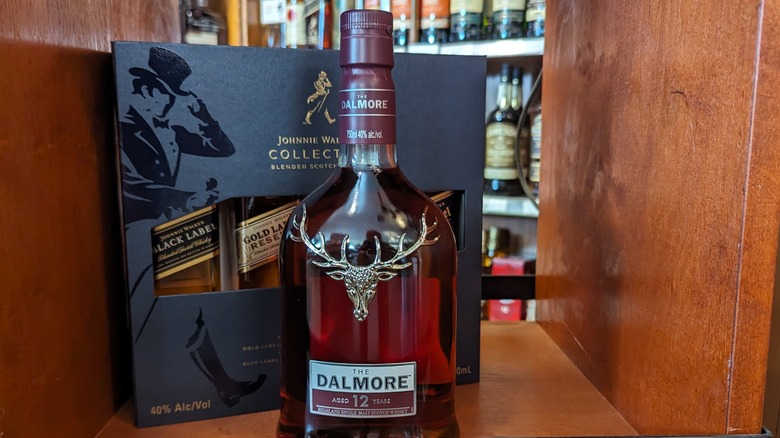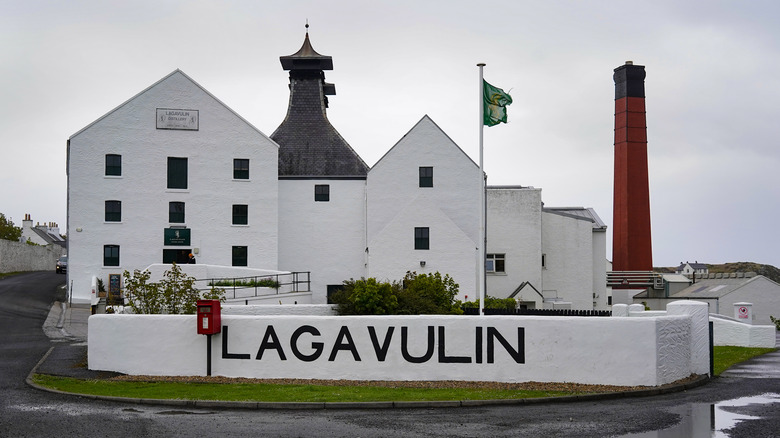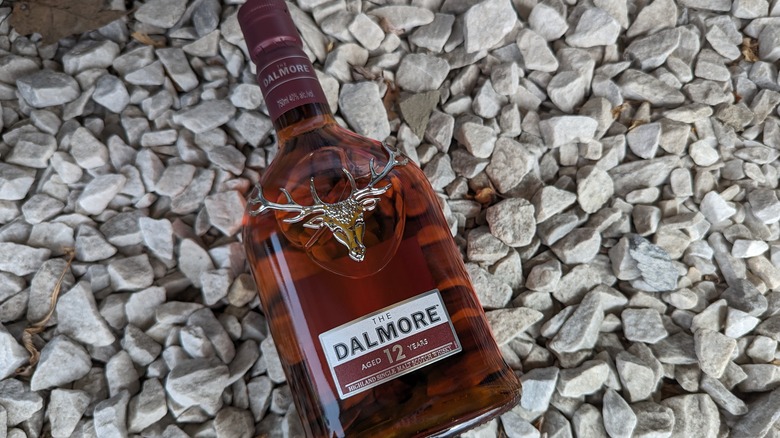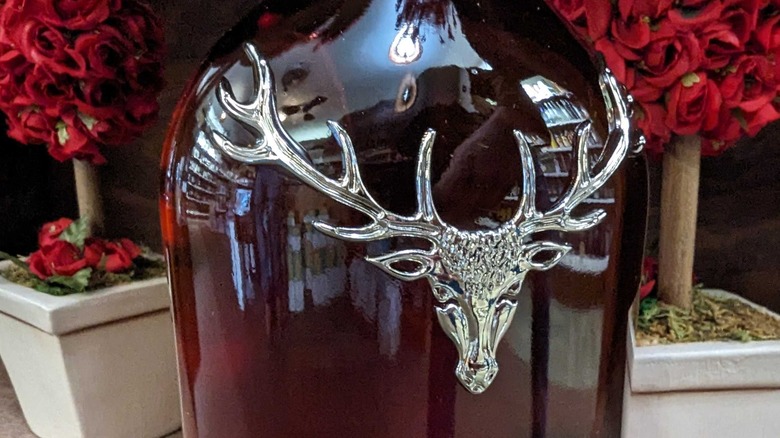The Dalmore 12 Single Malt: The Ultimate Bottle Guide
While Scotch whisky is often used to describe any whisky produced in Scotland, there is a great variation in quality, flavor, price, and history when it comes to Caledonia's spirit output. The Dalmore 12 is a good example of it. To put it simply, it's a 12-year-old single malt Scotch. Delve a little deeper, and it's a whisky of the highland variety. Keep delving and you'll hear stories about clan founders saving kings from early wildlife and Australians casting aside glasses of Victorian (the age, not the state) bitter in favor of a dram of the good stuff.
The Dalmore 12 comes in at around 40% ABV and retails for $68 to $80 a bottle in the United States — though this varies depending on location, taxation, and whether your local liquor store is running some kind of deal. As with other single malts, a master distiller has turned three ingredients: barley, water, and yeast, into something sweet, fruity, and unique. This isn't a quick process; the "12" in the spirit's name denotes the length of time it has spent maturing in a barrel, but the end result is more than worth the wait. The Dalmore 12 is one of the more widely available single malts, adorning many a bar's top shelf, taking up entire duty-free displays in most major airports, and cropping up in liquor stores across the United States. But don't rush out to get a bottle right away. Read on a little, and find out why you should first.
What does the Dalmore 12 taste like?
On the nose, you'll notice a fruity, spicy aroma with a hint of malt. An orange peel-like scent is quite prominent, and if you spend enough time with your beak in the glass, you'll detect coffee and chocolate notes as well. Anyway, this is a glass of whisky, not an air freshener, so on to the important stuff.
The Dalmore 12 is a very mild spirit. While not quite as gentle as something like its Speyside cousin Dalwhinnie 15, the alcoholic component still settles down in the back seat when this Scotch hits your tongue. At the fore are some refreshing fruity flavors, with a light citrus burst being the most prominent.
Some moderate vanilla notes appear somewhere in the middle ground and carry on into a warm, slightly sweet finish. This is evidence of the former bourbon casks made from white oak that most of the spirit spends over a decade maturing inside.
We would not describe The Dalmore 12 as an entry-level Scotch, nor is it anything advanced or exclusive. It's very drinkable and a great teacher if you're looking to develop your palate before moving on to more complex whiskies. The overall mildness allows you to take some time and let the flavors develop on your tongue. It also allows less experienced drinkers to eschew water or ice and comfortably sample the spirit at its full strength.
How is the Dalmore 12 made?
Dalmore is a single malt whisky, so as its name suggests it's the product of a single distillery. The distillery in question is the Dalmore Distillery and has operated in the far north of Scotland for over 180 years.
Single malts only have three ingredients: malted barley, water, and yeast. No other grains are involved. The barley is "malted" in a special room before being mashed to release its sugars. After a short time fermenting, the resulting mash is distilled, resulting in a clear spirit with a high alcohol content.
Many of the unique flavors and characteristics come from the water used and the aging process. Highland water is mineral-rich and can unlock both sweet and spicy notes in the whiskies that use it. Dalmore's multi-barrel process also contributes greatly to the Scotch's final flavor. The majority of the maturation process is spent in ex-bourbon barrels. The whisky will take on some sweetness from the bourbon residue present, along with some vanilla notes from the oak. With around three years left, half of the whisky is transferred to a sherry cask. This gives it a chance to absorb some of the fruity flavors left in the barrel by its previous occupant. During the aging process, the overall volume of the liquid is reduced due to evaporation and absorption into the barrel. This results in a product that is stronger than what is intended. Because of this, water is added to bring the spirit back to its intended ABV — which is 40% or 80 proof in this case.
How to drink the Dalmore 12
As with many things, there's a bit of debate centering around how to enjoy Scotch. Absolute purists will insist you drink it neat and can even be specific about the type of glass used. Others like their Scotch on the rocks or with a splash of water. Chilling drinks with things like ice, whisky stones, or a spell in the freezer will make them a little milder but also dull out other flavors. Many people insist adding some water can help open a single malt up and make its subtle flavors more noticeable. Despite the arguments, none of these practices will get you any funny looks in most establishments.
Your choice of vessel also plays a part. While a rocks glass is popular, Scotch should really be sampled from a container known as a "glencairn glass" which should channel the smells of The Dalmore into your nose before efficiently funneling the liquid into your mouth.
The one thing you should not do with a single malt like The Dalmore is use it with any kind of mixer or slap it in a cocktail. Part of the reason single malts are so expensive is the complex blend of flavors the spirits tend to provide. If you dump a can of Coke over your dram of Dalmore, you're not going to get most of these flavors. In fact, you'll get pretty much the same result as whiskies a fraction of the price will provide, so mixing your single malt Scotch with anything is generally considered a total waste. Mixing is why whiskies like Johnnie Walker Red and Monkey Shoulder exist.
Why is it so expensive?
The Dalmore 12 is a single malt Scotch, and like most other single malt Scotches, its high price point is a combination of several factors. The most significant one in the U.S. is tax. Scotland and the United Kingdom as a whole make a significant amount of money from Scotch. Depending on where you live, tax may account for up to 75% of the bottle's price tag. Beyond the money the U.K. and Scottish governments take from distilleries when the spirits are produced, import taxes may also apply in countries to which the spirit is shipped. Then there is the prestige aspect. Scotch is pretty aspirational in the grand scheme of things. Aspirational products come at a premium, as exclusivity adds to the reputation. Not everyone can afford to drop upwards of $100 on an addition to their liquor cabinet, especially when cheaper options can do a similar job.
Finally, there's everything that goes into a bottle of Scotch. Expert craftsmanship is needed to turn limited ingredients into something unique. The history that comes with processes that are sometimes centuries old and bound by traditions. And the fact it has to sit in a barrel, taking up a significant amount of space, for many years before it can be bottled and sold. In the case of The Dalmore 12, twelve years are spent in said barrels.
The Dalmore 12 vs. Lagavulin 16
On the face of it, The Dalmore 12 and Lagavulin 16 have a lot in common. They're both whiskies, they're both single malts, and they're both produced in Scotland. If you're reading the titles and nothing else, then you'll notice the four-year gap between them. The Lagavulin has spent four more years inside a barrel, so it should be a touch smoother and it will have taken on more of the characteristics of whatever kind of barrel it happened to be matured in.
While maturation time is a factor, the differences between the two bottles go far beyond that. They are two completely different whiskies, and even a complete novice would be able to tell the difference between the two by going off smell alone, never mind taste. Lagavulin is an Islay whisky produced off the west coast of Scotland. Whiskies of that type are known for their complex, smoky, and peaty flavors. They taste pretty medicinal until you can get used to them. Highlands from the west coast can be peaty, but not to the extent of an Islay. Highlands, in general, tend to be fruitier, and highlands from the North East of Scotland (where The Dalmore Distillery is located) tend to be rich and sweet.
Despite only having three ingredients, single malt Scotch is an incredibly diverse style of spirit. A few bottles can take you on an entire tour of Scotland. Just as The Dalmore distillery is far away from Scotland's western isles — The Dalmore 12 is a long way from Lagavulin 16 in terms of taste and smell.
Dalmore 12 was the first Scotch to be exported
Scotch exports account for a significant amount of Scotland's GDP and have a healthy impact on the U.K. economy too. You can find numerous bottles from over 100 distilleries and numerous blenders in stores throughout the world. But this wasn't always the case. None of Scotland's famous spirit was commercially exported until 1870. The first cases of Scotch being shipped abroad were sent to Australia, which is about as far from Scotland as you can get. Those cases contained The Dalmore 12, the only spirit produced by The Dalmore distillery until its range was expanded earlier this century. It obviously wasn't a waste of time as The Dalmore Distillery continued to export some of its wares, and many other distilleries followed suit.
Scotch exports, in general, have blossomed over the past 150 years, with a staggering 53 bottles per second leaving the nation's shores on average — but it all started with a few crates shipped down under.
The stag on the bottle comes from a 13th century legend
One of the most unique things about The Dalmore is the design of its bottle. The head of a metal stag, a 12-point buck to be precise, adorns the front of every container. The stag itself is the distillery's emblem, so it makes sense their logo would be on the front of all their products. However, the story behind the stag goes much deeper than that, stretching back almost 800 years. Legend has it that in 1263, a man called Colin of Kintail saved the life of Scotland's King Alexander III when the monarch got on the wrong side of a large and aggressive buck.
As a reward for saving the ruler's life, Colin was awarded an emblem based on the animal that nearly offed the king. Colin was the first Chieftain of Clan MacKenzie, and that clan went on to take control of the Dalmore Distillery in 1867. When the clan took over, the emblem of their founder was naturally an ideal choice when a symbol was needed for their new acquisition. One of the clan's first actions following the acquisition was to adorn each bottle with the stag as a guarantee of its quality.
Dalmore 12 was the distillery's only product for most of its history
The Dalmore Distillery currently produces a reasonable array of products. Its main line includes various bottles rated by maturation time, including The Dalmore 12, 14, 15, 18, and 21. Then there's The Dalmore King Alexander III — a special but not limited bottle named after the monarch saved by the founder of Clan MacKenzie; Cigar Malt Reserve, which is designed to accompany a fine cigar; and a couple of cask-related editions — Port Wood Reserve, and Sherry Cask Select 12. Then there are the limited edition bottles. This includes select editions from 2005 and 2008, the "Luminary" collection, and three "cask curation" bottles ranging from 26 to 43 years old.
But it wasn't always like this. Up until 2002, The Dalmore 12 was the only thing that the distillery produced. In the 20-something years that have passed, its product range has expanded greatly. And yes, some of the more mature products available, such as the 26, 28, and 43-year-old bottles, will have been planned long before that range expanded, but The Dalmore Distillery still spent over 150 years focused on a single product. So although there are rarer, more expensive whiskies produced by The Dalmore, the 12-year-old version has the most heritage to call upon.
